1. INTRODUCTION
Dietary fiber as a feed component in poultry nutrition has traditionally been given little consideration, as it has only a low nutritional value from a chemical point of view (Röhe and Zentek, 2021). However, recent studies have reported that dietary fiber content is associated with alterations in growth capacity (Sadeghi et al., 2015) and general regulation of the gastrointestinal tract of broilers (Owusu-Asiedu et al., 2006). Chemically, dietary fiber consists of non-starch polysaccharides and lignin (Theander et al., 1994). Depending on their water solubility, non-starch polysaccharides can be divided into soluble and insoluble non-starch polysaccharides, which have different effects on the digestive tract when fed to animals. Dietary fiber consists primarily of carbohydrate polymers (non-starch polysaccharides), which are components of plant cell walls, including cellulose and hemicelluloses. Associated substances, principally lignin, and minor compounds, including waxes, cutin, saponins, polyphenols, and phytosterols, are also included (Căpriţă et al., 2010). The soluble non-starch polysaccharides are rapidly fermented by resident microbes in the distal small intestine and large intestine, increase digesta viscosity, reduce digesta passage rate through the intestine, and can decrease feed intake due to increased satiety. On the other hand, insoluble non-starch polysaccharides passes through the intestine undigested, increases passage rate and fecal bulking (Hetland et al., 2004).
Lignocellulose, a constituent of plant cell walls, is mainly composed of insoluble non-starch polysaccharides, such as cellulose, hemicellulose, and phenolic lignin (Heo and Choi, 2017; Kim et al., 2017; Liu et al., 2014; Yanti et al., 2019). In the last decade, few studies have examined the use of dietary lignocellulose for different farm and companion animals, revealing potential effects on digestive physiology and function (Slama et al., 2020). In a previous study, oak wood chips were fed to broiler feed, and their potential as a dietary fiber source was evaluated. Although the feeding of 1%–2% dietary lignocellulose did not affect nutrient digestibility, the apparent total tract digestibility of fats and fatty acids increased in broilers fed with 1% lignocellulose (Jung et al., 2019b).
Pine is one of the major plantation tree species in Korea (Jung et al., 2019a; Lee et al., 2020; Min et al., 2019). In addition, pine trees contain a significant amount of cellulose, hemicellulose, and lignin that can be used as dietary fiber sources. Most of the pine is crushed into chips or sawdust, and are mainly used as litter for improving the growth environment of broilers, and rarely used for feeding (Mandey et al., 2017; Smalberger and Rensburg, 2021).
Steam explosion is an effective technique used in food processing to improve the soluble dietary fiber content (Jung and Yang, 2018; Sui et al., 2018). Research has shown that steam explosion can increase the soluble polysaccharide content in fibers by degrading cellulose and hemicellulose and breaking the glycosidic and hydrogen bonds (Wang et al., 2015; Wang et al., 2019). In this study, the chemical and physical properties of steam-exploded pine chips were analyzed by varying the severity factor from 3.1–5.0 to evaluate the possibility of substituting dietary fiber for broilers.
2. MATERIALS and METHODS
Pine (Pinus densiflora) was collected from the experimental forest of Gyeongsang National University, Jinju, Korea. The pine was chipped to a particle size of approximately 2 × 2 × 0.5 cm3 for steam explosion and stored at 20°C at a moisture level below 10%–15%.
The chipped pine material was treated according to the conditions listed in Table 1. Each experimental condition was expressed in terms of a severity factor log (Ro) (Eq.1), which combines reaction temperature and retention time (De Bari et al., 2002).
| Severity factor (Ro)1) | Reaction temperature (°C) | Reaction time (min) |
|---|---|---|
| 3.1 | 190 | 3.0 |
| 3.5 | 200 | 3.5 |
| 4.0 | 210 | 6.0 |
| 4.5 | 220 | 10.0 |
| 5.0 | 230 | 15.0 |
Dietary fiber content was based on the AOAC enzyme gravimetric method (AOAC, 2000). Steam exploded pine was mixed with thermo-stable α-amylase at 95°C and stirred continuously for 30 min. After the mixture cool down to 45°C, protease was added and stirred continuously for another 30 min. Then, the pH of the mixture was adjusted to 4.5, amyloglucosidase was introduced, and the mixture was continuously stirred at 55°C for 30 min. The insoluble dietary fiber was separated by centrifugation at 1,000×g for 15 min and soluble dietary fiber was precipitated with 95% ethanol. Dietary fiber was calculated as the sum of the insoluble and soluble dietary fibers.
The carbohydrate composition and lignin content of the steam exploded pine was determined by the American Society for Testing and Materials (ASTM method E1821-96, 1996). The first step involved exposure to 72% H2SO4 at 30°C for 60 min. In the second step, the reaction mixture was diluted to a final H2SO4 concentration of 4% and subsequently autoclaved at 121°C for 1 h. The solid residue remaining after acid hydrolysis was considered to be the lignin content. After hydrolysis with sulfuric acid and conversion into alditol acetates, the carbohydrate (arabinose, xylose, mannose, galactose, and glucose) content of this hydrolyzed liquid was analyzed by gas chromatography (GC) in a YL6100 device (Young Lin Ins., Seoul, Korea).
Water-holding capacity was defined as the quantity of water bound to the fiber without applying any external force (except for gravity and atmospheric pressure). A 0.1 g sample was soaked in 10 mL of distilled water for 24 h. The mixture was centrifuged at 2,000×g for 30 min and the supernatant was discarded. The water-holding capacity was expressed as milliliters of water held by 1 g of fiber (Chau and Huang, 2003).
Oil-holding capacity was defined as the quantity of oil bound to the fiber without applying any external force (except for gravity and atmospheric pressure). A 1.0 g sample was weighed in a centrifugal tube, to which 10 mL edible sunflower oil was added and mixed well. The sample tube was kept for 1 h at room temperature and subsequently centrifuged at 2,000×g for 20 min. The oil-holding capacity was expressed as milliliters of oil held by 1 g of fiber (Chau and Huang, 2003). The density of sunflower oil was 0.88 g/mL.
The swelling property is defined as the ratio of the volume occupied when the sample is immersed in excess water after equilibration to the actual weight. One gram of sample was weighed and placed into a tube and the volume recorded. Then, deionized water was added at a solid/water ratio of 1:30 (w/v) and mixed well. The sample tubes were left at room temperature for 18 h and the volume of samples was recorded after swelling upon water absorption. After 18 h, the final volume of the fiber was measured (Zhang et al., 2011).
3. RESULTS and DISCUSSION
The recovery of the solid fraction after steam explosion at different Ro is shown in Fig. 1. The solid recovery ranged from 79.5%–98.2%, depending on the Ro of the steam explosion. In the Ro range of 3.1–4.0, the solid recovery was > 90%, and in the range of 4.5–5.0, the solid recovery was approximately 80%. Higher solubilization was obtained under harsh conditions, showing a significant effect of steam explosion’s Ro value (reaction temperature and reaction time) on solids recovery.
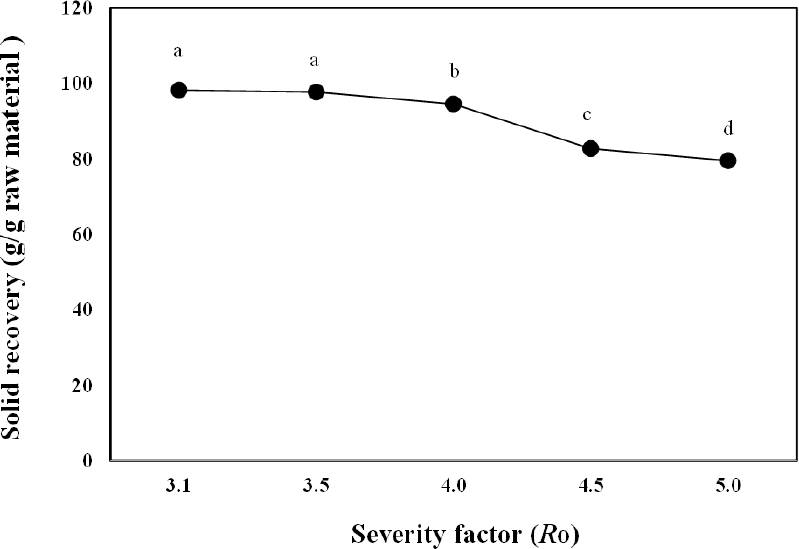
Fig. 2 shows an image of pine chips that have been subjected to steam explosion with different Ro, showing that the color and texture changed according to the Ro. The higher the Ro, the darker the brown color and the fibrous texture. The steam explosion ruptures the biomass fiber rigid structure, changing the starting material into a fibrous dispersed solid (Reis et al., 2020).

The insoluble and soluble dietary fiber content of steam-exploded pine chips obtained from Ro 3.1–5.0 are shown in Fig. 3. According to the Ro, the insoluble dietary fiber content ranged from 70.5%–82.2%, and the soluble fiber content ranged from 0.3%–0.5%. The insoluble dietary fiber content decreased as the Ro increased and decreased sharply in the range of 4.0–4.5. Although a small amount of soluble dietary fiber was contained, its content increased in the steam-exploded pine chip with the Ro of ≥ 4.0. These results demonstrate that the composition of insoluble and soluble dietary fibers changes when the Ro is ≥ 4.0. A previous study reported that steam explosion could increase the soluble dietary fiber content since it can break down, deteriorate, and degrade insoluble dietary fiber into soluble dietary fiber (Li et al., 2019).
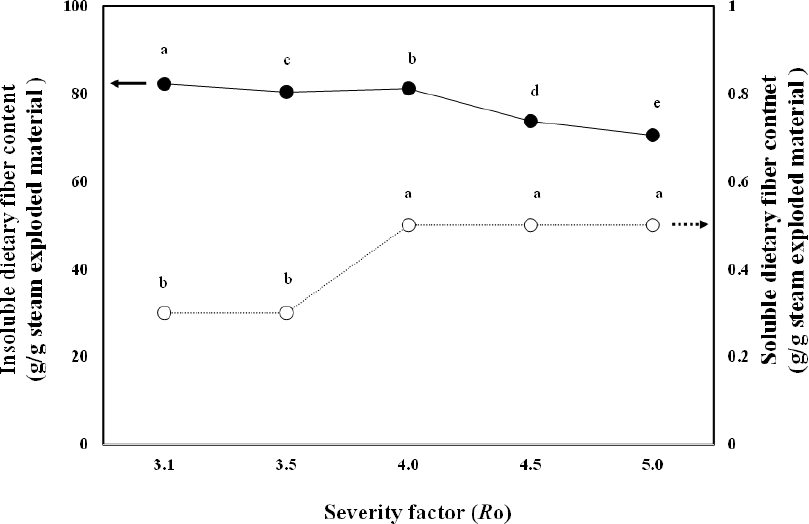
As cellulose is insoluble in water, it can bind water, increasing fecal volume and thus promoting regular bowel movements. Hemicelluloses also directly bind cholesterol in the gut, preventing cholesterol absorption (Mudgil and Barak, 2013). The glucose content represents cellulose, and the arabinose, xylose, mannose, and galactose contents represent hemicellulose. Fig. 4 shows the cellulose and hemicellulose contents of pine chips treated with the Ro of 3.1–5.0. The cellulose and hemicellulose contents decreased as the Ro increased during the steam explosion. The cellulose content ranged from 24.5%–38.6% and the arabinose, xylose, mannose, and galactose contents ranged from 0.0%–1.1%, 1.5%–3.9%, 1.5%–4.7%, and 1.3%–3.5%, respectively. During the steam explosion, the actions of acid-like hydrolysis, thermal degradation, mechanical fracture, and hydrogen bond destruction can degrade and destroy the cellulose and hemicellulose into soluble dietary fiber (Jung et al., 2017). The soluble dietary fiber content showed a tendency to increase with the steam explosion (Fig. 3).
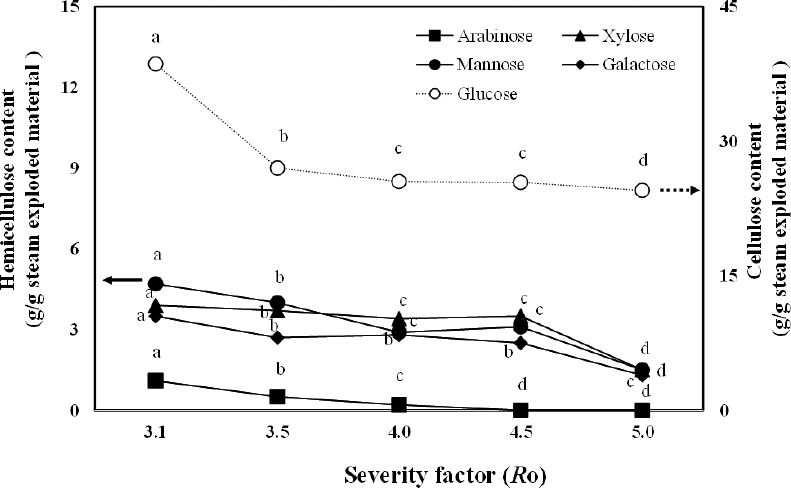
Lignin is a complex polymer containing coniferyl, sinapyl, and p-coumaryl alcohols. It is relatively inert due to its strong intramolecular bonding, including carbon-to-carbon linkages. In addition, it is more resistant to digestion than any other naturally occurring polymer (George et al., 2020).
Fig. 5 shows the lignin content of the steam-exploded pine chips with different values of Ro. The lignin content of the steam-exploded pine chip with the Ro of 3.1–5.0 was in the range of 34.4%–49.9%. The lignin content increased as the Ro increased, and the Ro ≥ 4.5 showed that the lignin content was ≥ 40%. The results can be attributed to decreased cellulose and hemicellulose contents. Lignin is classified as an insoluble dietary fiber and exerts beneficial effects on the intestines (Theuwissen and Mensink, 2008). Thus, steam-exploded pine chips may be effective as a dietary fiber source.
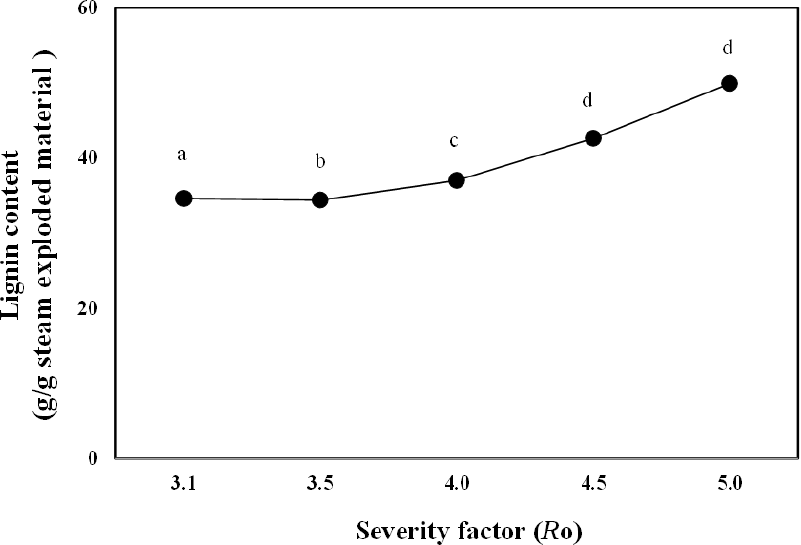
In general, the polysaccharide constituents of dietary fiber are strongly hydrophilic. Water is held on the hydrophilic sites of the fiber itself or within the void spaces in the molecular structure (Fleury and Lahaye, 1991). Water-holding capacity is important indicators to evaluate the functions of dietary fiber because they are always closely related to the cholesterol-lowering ability of dietary fiber (Li et al., 2013). As shown in Fig. 6, the water-holding capacity was found to be in the range of 6.3–8.3 g/g in the steam-exploded pine chip treated with Ro 3.1–5.0. The Ro value of the steam explosion might significantly affect the water-holding capacity of the pine chip. The water-holding capacity increased up to the Ro of 4.0 but decreased sharply in steam-exploded pine chips with 4.5 and 5.0 Ro. The results can be attributed to changes in the composition of soluble and insoluble dietary fibers, depending on the Ro of steam explosion (Fig. 3). Cadden reported that the physical properties of dietary fiber, especially hydration, depend on the insoluble fiber/soluble fiber ratio, particle size, extraction conditions, and source (Cadden, 1987).
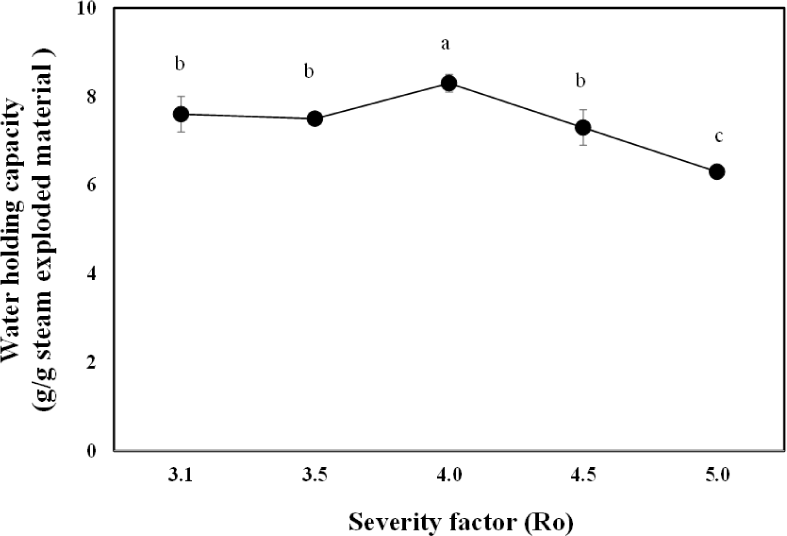
Oil-holding capacity assesses the ability of dietary fibers to prevent fat or oil loss during food processing and reduce serum cholesterol levels by binding fat or oil in the human digestion system (Navarro-Gonzalez et al., 2011). As shown in Fig. 7, the oil-holding capacity of the steam-exploded pine chips with the Ro range of 3.1–4.0 increased significantly to 5.4–6.5 g/g, respectively, after the steam explosion. It was inferred that steam explosion could consequently increase the physical entrapment of oil, thereby increasing the oil-holding capacity. However, at the Ro of ≥ 4.5, the oil-holding capacity sharply decreased. Sangnark and Noomhorm (2003) reported that the smaller particle size of dietary fiber was associated with lower oil-holding capacity. It is thought that the particle size decreased when steam explosion was performed with Ro of ≥ 4.5.
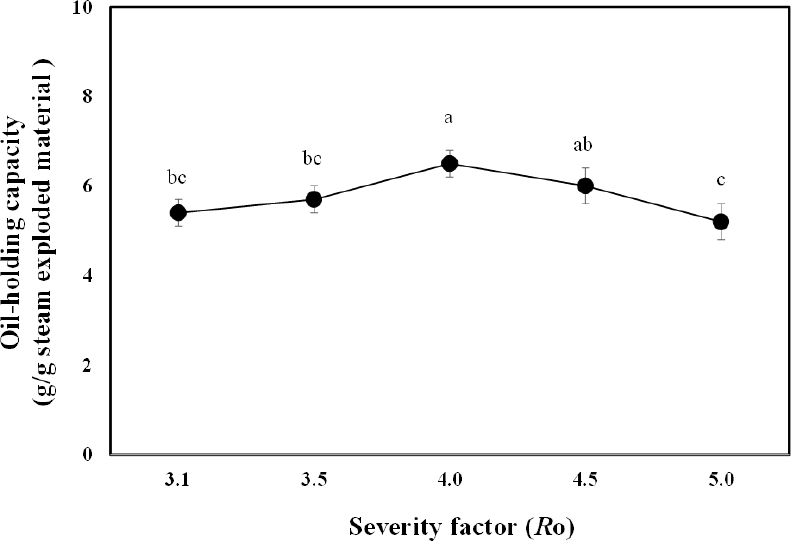
Swelling capacity is an indicator of hydration characteristics, such as the water-holding capacity. As shown in Fig. 8, the swelling capacity of the steam-exploded pine chip increased after the explosion treatment. The swelling capacity showed a high value at the Ro of 4.0–4.5 and a sharply decreased value at the Ro of 5.0. The hydration properties are related to the porous matrix structure formed by polysaccharide chains, which can hold large amounts of water through hydrogen bonds (Kethireddipalli et al., 2002).
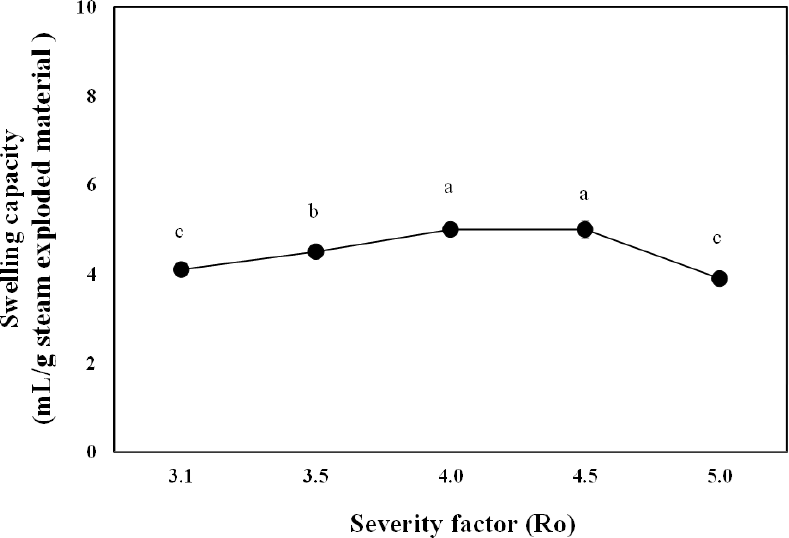
4. CONCLUSION
Pine chips are an important source of dietary fiber in the broiler feed industry. In terms of chemical properties, steam explosion reduces the cellulose and hemicellulose content in pine chips but increases the lignin content. As a result, steam-exploded pine chips redistribute fiber components from insoluble to soluble dietary fiber. When treated with an Ro of 4.0, the water-holding capacity, oil-holding capacity, and swelling capacity increased, and severe conditions of ≥ 4.5 showed a sharp decrease. The steam-exploded pine chip will provide useful insights into the potential applications in the broiler feed industry.
